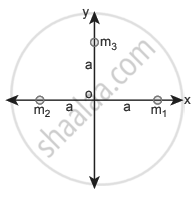Advertisements
Advertisements
प्रश्न
Two bodies of masses m and 4m are placed at a distance of r. Calculate the gravitational potential at a point on the line joining them where the gravitational field is zero.
उत्तर
Let the point be the position when the gravitational field is zero.,
`("Gm")/"x"^2 = ("G"(4"m"))/("r" - "x")^2`
`1/"x"^2 = 4/("r" - "x")^2`
Square root on both sides,
`1/"x" = 2/(("r" - "x"))`
∴ x = `"r"/3`
The point P is at a distance `"r"/3` from mass ‘m’ and `"2r"/3` from mass ‘4m’
Gravitational potential V = `(-"Gm")/(("r"/3)) - ("G"(4"m"))/(("2r"/3))`
= `(-3"Gm")/4 - (3"G"(4"m"))/(2"r")`
= `(-3"Gm")/"r" - (12"Gm")/(2"r")`
V = `(-9"Gm")/"r"`
APPEARS IN
संबंधित प्रश्न
If the masses of the Earth and Sun suddenly double, the gravitational force between them will ___________.
The work done by the Sun’s gravitational force on the Earth is __________.
An object of mass 10 kg is hanging on a spring scale which is attached to the roof of a lift. If the lift is in free fall, the reading in the spring scale is ___________.
Is potential energy the property of a single object? Justify.
Define gravitational potential.
Derive the expression for gravitational potential energy.
The work done by Sun on Earth at any finite interval of time is
Calculate the gravitational field at point O due to three masses m1, m2 and m3 whose positions are given by the following figure. If the masses m1 and m2 are equal what is the change in a gravitational field at the point O?

What is the gravitational potential energy of the Earth and Sun? The Earth to Sun distance is around 150 million km. The mass of the Earth is 5.9 × 1024 kg and the mass of the Sun is 1.9 × 1030 kg.
An object is thrown from Earth in such a way that it reaches a point at infinity with non-zero kinetic energy `["K"."E"("r" = ∞) = 1/2 "Mv"_"∞"^2]`, with what velocity should the object be thrown from Earth?
